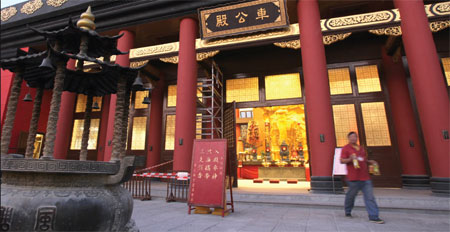Villagers demand return of Che Kung Temple
Updated: 2011-12-03 07:07
By Guo Jiaxue(HK Edition)
|
|||||||||
|
A man walks out of Che Kung Temple in Tai Wai, Sha Tin, on Friday, carrying in his hand three bottles of food oil that worshippers offer as sacrifice to the deity. The temple is the biggest money-making temple among those directly administered by the Chinese Temples Committee. Edmond Tang / China Daily |
Sha Tin villagers have kicked off a property war over Che Kung Temple, one of the most popular temples in the city.
They are challenging the government's ownership over the property extending nearly 80 years.
The Sha Tin Rural Committee decided on Friday to set up a special team to urge the government to return ownership to all Sha Tin indigenous villagers.
Chairman of the committee Mok Kam-kwai said the villagers have not decided whether to go to court, but prefer dialogue with the government first.
Some villagers suggested protesting at the temple during the coming Che Kung Festival, on the second day of the first lunar month, when most people worship at the temple for good luck every year.
Mok, presenting a document provided by an old villager, said it has been proven that in 1929 the old Che Kung Temple was registered to all Sha Tin indigenous villagers.
Three years later, because of constant conflicts among villagers, Hong Kong government took over the ownership of the old temple through a transfer signed by two temple trustees.
However, Mok charged the government "wrongly enforced the court judgments".
The Supreme Court in 1932 ruled the property "vested in the Secretary for Chinese Affairs Incorporated (now the Secretary for Home Affairs Incorporated) for the estate of Wai Fu-wo and Tsang Kwong-yan therein".
Mok said the old temple was managed by the two trustees, but not the estate.
Now the villagers want the ownership of the old temple back. They also want control of the new, larger Che Kung Temple, which is nearly 9,000 sq ft, and attracts 500,000 worshipers every year.
"In my view, the two are simply together," Mok said.
He defended his statement, citing the fact that the Secretary for Home Affairs Incorporated in 1992 made an agreement with Lands Department, to submit the land of the original temple in exchange for a much larger area at the front for expansion. Therefore the present temple was built in a cost of HK$48 million to cope with growing numbers of visitors. The old temple is not open to public any longer.
Among all 24 temples directly administered by the Chinese Temples Committee, Che Kung Temple is the biggest money-making one. Worshipers donate more than HK$13 million to the temple every year, according to Oriental Daily.
When asked whether the villagers want to acquire the land so as to build a columbarium niche, Mok said: "No".
If Sha Tin villagers could get the temple back, Mok said, they would still want to use the huge amount of donations for charity work.
The Home Affairs Department said it will seek legal opinions before getting back to the rural committee.
The department issued a short statement, stating the arrangement for Che Kung Temple fully respects and complies with the court's decision.
But it said it will take quite some time to go through documents dating all the way back to the 1930s.
guojiaxue@chinadailyhk.com
China Daily
(HK Edition 12/03/2011 page1)
